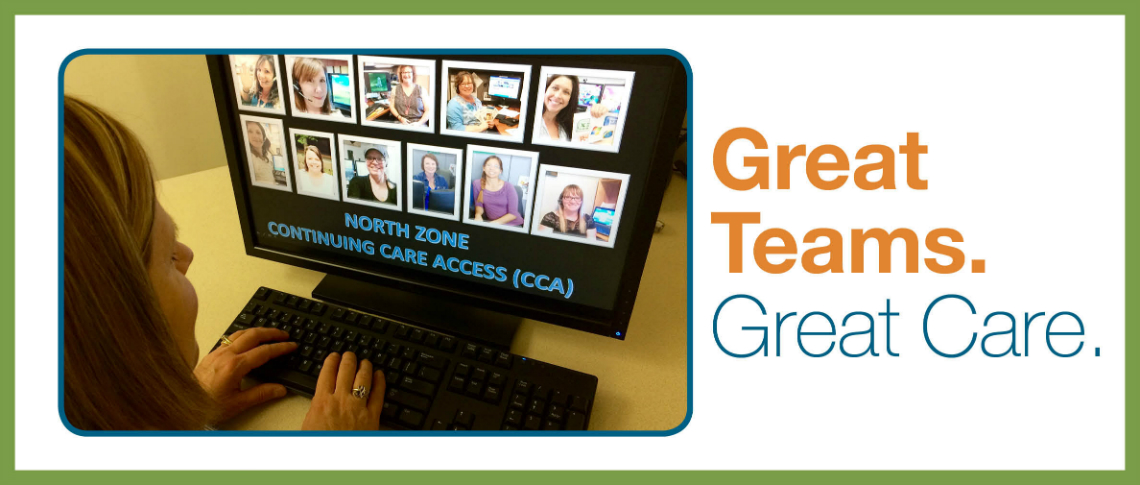

Story by Joanne Neilsen
With two-thirds of Alberta’s land mass included within its boundaries, AHS’ North Zone is a big place. In fact, it’s about the same size as France.
So it’s understandable that helping people access healthcare requires a broad understanding of how the health system works, where to find health facilities and how to get there.
That’s where the North Zone’s Continuing Care Access (CCA) team comes in.
This virtual team includes 11 intake nurses (RNs) and one support person. Together, they operate a toll-free call centre to answer healthcare questions seven days a week (8:15 a.m. to 8 p.m. weekdays; 8:15 a.m. to 4:30 p.m. weekends).
“Our team’s skill and knowledge is expansive and varied — and it needs to be,” says Janet Kaplan, Manager, Continuing Care Access North Zone. “We never know who will be calling, or why. Our work changes all day long.”
They take calls from anyone needing information on continuing care services or help to navigate the health system. Callers can range from individuals and someone’s concerned family member or neighbor to doctors, acute care nurses, and community agencies.
Team members work on several online technology systems at once to provide callers with up to date information on home care, long-term care, adult day programs, specialized clinics, rehabilitation services, post-surgery support, and accessing aids to daily living such as walkers and wheelchairs. They also use a community resources directory to find local services such as Meals on Wheels.
“Our work isn’t just seniors-based; we help people of all ages,” explains Kaplan.
The nurses complete an intake and assessment to determine an individual’s healthcare needs and refer them to the most appropriate healthcare provider or service. They also respond to medical referrals from hospitals and healthcare providers for clients requiring home care, rehabilitation services, and designated supportive living.
“Knowing the lay of the land is imperative,” says Kaplan. “There are a lot of intricacies in understanding our Range Roads and how to get to a village or community. Our team is very knowledgeable on Alberta geography—they are my go-to folks when planning road trips!”
Kaplan says they practice a ‘no wrong door’ policy and will search for resources to assist clients in their healthcare journey by listening, being supportive and quickly building rapport and trust.
“Sometimes people feel overwhelmed,” she says. “We lend a caring ear and walk them through the next steps. When people have the right information, their fears are alleviated. We help lift that weight off their shoulders and can ‘feel’ their relief.”
Kaplan describes her team as service coordinators and navigators with uncanny abilities to assess the differing needs of clients.
“Sometimes we’re playing the role of detective, and sometimes counselor,” she says. “We’re very skilled at active listening, asking key questions and using assessment tools to draw out the information needed to help them.”
While team members work independently or in small groups, they reach out and help one another to problem-solve.
“We all work in different locations, so we need to keep the lines of communication open,” says Leslie Demoissac, a call centre RN located in St. Paul, Alberta. “Our strength lies in our ability to communicate and collaborate.”
Supporting the care needs of people living in rural and remote northern communities, pose a variety of challenges not seen in larger urban centres.
“Many of the smaller towns have no public transit or even taxi services,” explains DeMoissac. “Clients that return to a rural home, like a farm that is 30 minutes out of town, may be very isolated and need support more than just medical care.”
“Every community office we work with is so different,” says Demoissac. “We may get referrals for daily wound care in a community that only has Homecare services on specific days – most of the smaller Homecare sites have very different schedules than you would see in a city like Edmonton. Some clients with complex medical and social needs won’t have family support at home and may need to have services coordinated in other communities, or need help accessing local volunteer organizations and community agencies.”
Kaplan explains that using communication tools like Lync (or Skype) and TeleHealth is vital for connecting the team.
“We value and rely on one another, even though our home communities are hundreds of miles apart, says Kaplan. “We’ve purposely built a team culture where people are engaged and happy, with great support,” says Kaplan.
Since 2013, the number of incoming calls and referrals has increased by 24 per cent. The call centre also assists during emergencies to provide resource information and support to Home Care clients.
“People used the call centre as a contact point during the Fort McMurray fire,” says Kaplan. “Our team was excited to take on anything to support anyone through that disaster.”
The team knows the importance of finding a work-life balance and staying engaged. To help bridge the distances between them, they make time to connect in creative, fun ways.
“We make team cookbooks, participate in walking challenges and celebrate special days via Telehealth, whenever we can,” says Kaplan.
On average, in 2016 CCA received
2016 referral sources breakdown
1,842 referrals transferred to other zones